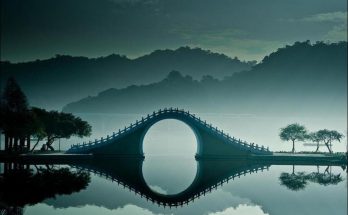The Tokugawa clan still ruled Japan in the 1850’s when Admiral Peary sailed into Tokyo Bay and called upon the Japanese to end their two and a half centuries of hermitage. Repeated overtures to this end had been declined earlier, and Japanese administration had been extended to Hokkaido early in the nineteenth century to prevent Russian encroachment. The American overture was more than a casual invitation, however, for it was made through a show of military force which was not lost upon the Tokugawa.
Though they still held firm control internally they were quick to realize that Japan could not stand up to outside forces that could muster many large guns in the big steam naval vessels such as those in the American fleet. Within a few years they had signed trade treaties with several occidental countries, and had taken the first steps to modernize their own military establishment. This was the fourth time that a small group had changed the whole course of Japanese history.
The changes could not be undone, but they were the undoing of the Tokugawa and of the old order of feudalism in Japan. The emperor and the other clans that ruled Japan under Tokugawa control had not had the foreign fleet in their own home ports and were inclined to expel the foreigners. A few “incidents” soon convinced other leading clans of the futility of resistance to the outside world. The Satsuma clan of western Japan turned to developing a modern navy, and the Choshu clan began the building of a modern army.
General opposition to the long rule of the Tokugawa took the form of restoring the emperor to a kind of power than the imperial family had not exercised for centuries, swept the Tokugawa from internal control, and started Japan on a course of modernization that both startled and impressed the whole world in the 75 years between 1866 and 1941. The Tokugawa had committed Japan to this program without the original support of the country, but other clans took over the lead, carried on the program, and managed to retain control of Japan until the end of World War II. Japan entered upon this new era in sound economic, social, and political circumstances, for there had been no time for a long series of disastrous internal wars to dissipate either population or resources.
A first step in modernization was the abolition of landed feudalism and the outmoded administration of government. Direct rule by the emperor and a bureaucracy, the abolition of feudal fiefs (for a reasonable price in government bonds), the establishment of new political administrative regions, and the pensioning off of the old regional rulers and the parasitic soldier group were the first steps in internal organization. This process, of course, gave to the ruling classes privileged opportunities for those members discerning enough to take them. Some old clans rose to new political power, and others acquired new economic strength, but it is notable that in general the control of Japan continued in the hands of the same general groups that had run Japan for many centuries.
Though the Tokugawa had actually sent a few observers abroad before the opening of the country, Japanese culture was sadly out of date compared to the industrial, military culture of the West. Realizing this the new leaders of Japan fell back upon a useful precedent, that of sending students abroad to study the superior cultures. Since many of these new leaders were derived from the old military clans and the professional soldiery, their first concern was the building of a strong military force which could deter the colonial imperialism of the Occident. Appreciating also that such a force could now be built only upon the basis of an industrial technology, they undertook a thoroughgoing industrialization.
So for nearly 50 years the Japanese government sent commissions, study groups, observers, and students all over the world to study the material economy of the West in a determined effort to bring Japan up to date as quickly as possible. German military and medical science, French and German law, British ship building, and the railroad and manufacturing techniques, and the business methods of the United States were all carefully studied. Observers all over the world studied the patterns of trade, colonial imperialism, the developments of agriculture, mining, transportation, and architecture. Educational systems and political institutions were examined.
The Japanese government took the lead in these matters, paying for the studies and then subsidizing the developments in Japan. The first railway was built between Tokyo and Yokohama in 1872, and by the end of the century hundreds of power plants and factories were operating. The operation of concerns was turned over to private companies formed by the leading clans, so that not only did Japan industrialize rapidly, but also the control of the modern aspects of the economy remained in the hands of the old leading elements. It is a commonplace to say that in a non-industrial country the evolution of manufacturing begins slowly and somewhat on a hit-and-miss basis. Not so in Japan, for by 1900 most of the kinds of things being done abroad were also being done in Japan. As new industrial developments occurred abroad Japanese continued to study them and to adapt them at home.
In the first few decades of modernization industrial skills were not sufficient to keep pace with developments of the economy, operating efficiency was rather low, and the occidental rather easily came to the conclusion that the Japanese were not creative but only imitative. It should be sufficient to remind an American, however, that as late as the end of World War II the United States was still following the lead of Germany in many matters of industrial evolution to put the question of copying in proper balance. The amazing thing is that Japan went at modernization in a wholesale manner, in the way in which she had studied Chinese culture centuries earlier, and in a way seldom attempted by any other society. This was long-range planning well before five-year plans became the vogue.
Visits: 163



